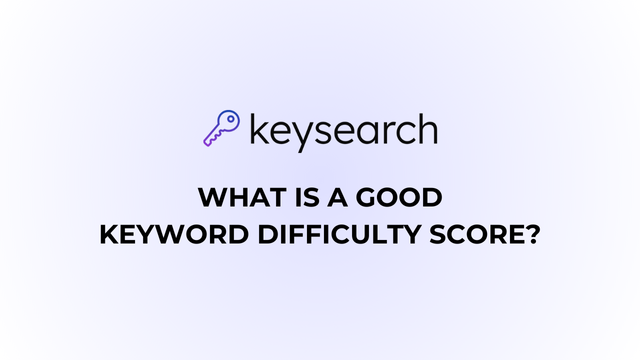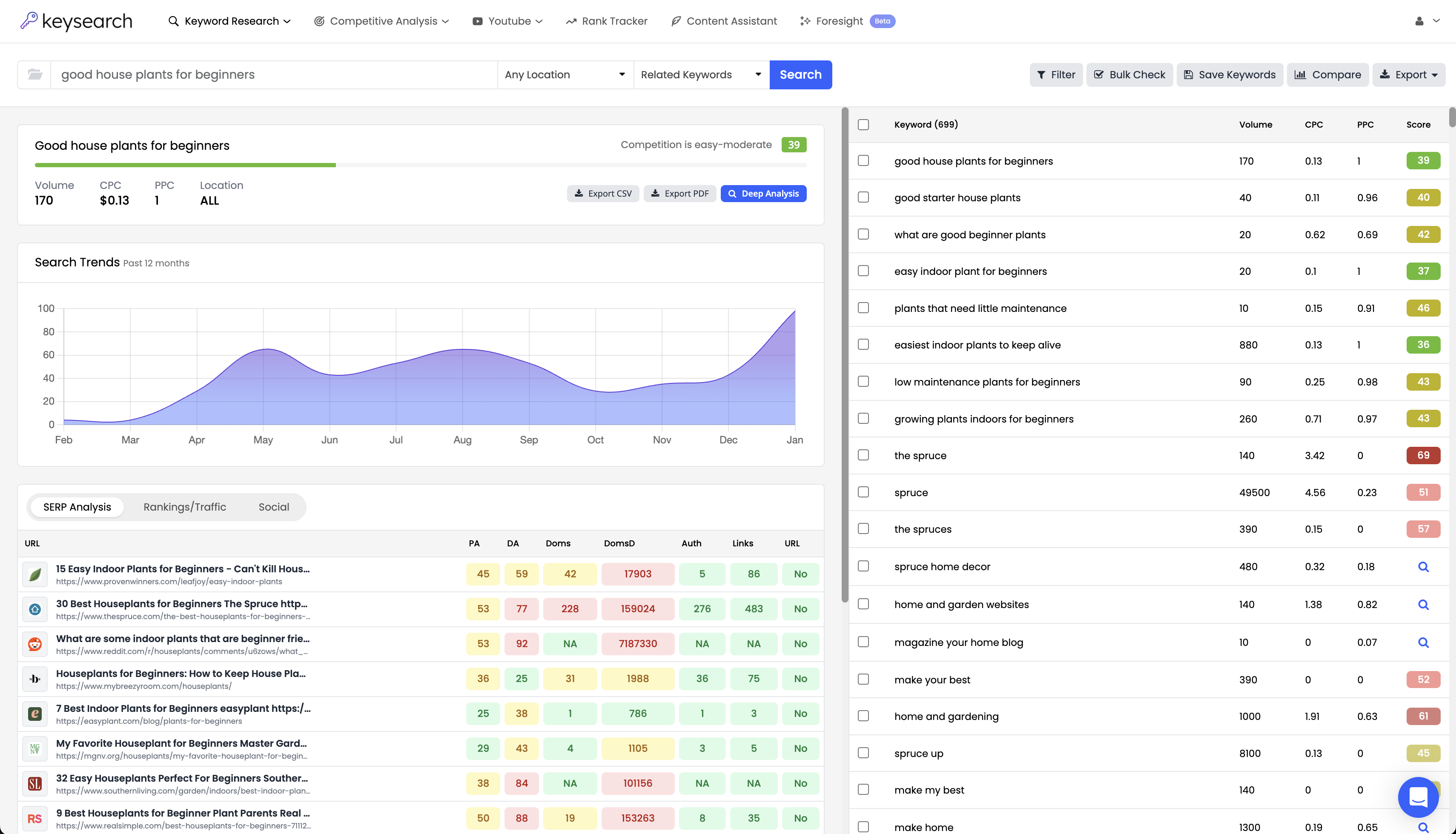While search volume is often put in the keyword research spotlight, assessing difficulty is just as important, if not more so.
We see so many small bloggers and large businesses alike narrow their focus on what they think is the best keyword – dumping resources into backlinking, content creation, and other on-page SEO measures. Yet, the needle doesn’t budge, and they end up spinning their tires.
The harsh reality is there are keywords you simply can’t rank for – at least not yet while you build up your own domain authority. In the meantime, you need to be more realistic and targeted in your efforts.
So, what is a good keyword difficulty score to shoot for? If only it was as easy as us giving you a number! There are far too many moving pieces, but we generally recommend those just starting out narrow their efforts to keywords with less than a KD rating of 30.
Learn more about this metric below and how you can use it to be more thoughtful and meticulous in planning and executing your SEO strategy, including why our free keyword difficulty checker is the #1 tool at your disposal for assessing how tough it will be to rank!
What is Keyword Difficulty?
What is keyword difficulty in the first place? This is a metric used in SEO to evaluate how challenging it is to rank for a specific keyword in search engine results pages (SERPs).
It helps you understand the level of competition you’ll face when trying to achieve high rankings for a chosen keyword. This makes it an essential piece of the keyword research puzzle, guiding decisions on which keywords to target based on the resources available and the likelihood of success.
Distinguishing From Keyword Competition
Before we go any further, it’s important that we distinguish keyword difficulty from keyword competition. They sound similar but actually measure two very different things:
- Keyword Difficulty measures the effort required to rank organically for a keyword. It assesses the strength of the websites currently ranking in the top positions, taking into account factors like domain authority, page authority, backlink profiles, and the quality of the content. A high score means it’s harder to achieve a top ranking for that keyword.
- Keyword Competition, on the other hand, focuses on the paid search landscape. It indicates the number of advertisers bidding on a keyword in platforms like Google Ads. This metric is reflected in the cost-per-click (CPC) rates. Higher competition means more advertisers are vying for the keyword, driving up the CPC.
Thus, the applications are very different. You may use both if you run paid ads and you’re implementing an SEO strategy. You may even find that there is a correlation between the two – but let’s narrow our focus just to keyword difficulty for now.
Why Keyword Difficulty is Just as Important as Search Volume (If Not More So!)
Those just getting started with SEO tend to focus on search volume. After all, the higher the search volume, the better the potential for organic traffic and conversions, right?
Yes, that’s true. However, search volume should not be the sole determinant of how you prioritize your keywords. It needs to be taken with a grain of salt – and in this case, that grain of salt is keyword difficulty.
Targeting high-volume keywords with high difficulty can be a waste of resources, especially for newer or smaller websites. These sites may struggle to compete against established players. High-difficulty keywords require much more effort in content creation, backlink building, and overall SEO optimization.
Instead, focusing on keywords with lower difficulty scores provides more realistic opportunities to achieve higher rankings and gain visibility. Yes, the traffic potential is lower – but it’s better than allocating budget toward high-competition keywords that you never actually end up ranking for.
There’s also the role of relevance in choosing keywords, which search volume does not take into account. Remember that the goal is always conversions, not traffic just for traffic’s sake. Lower search volume that moves the needle trumps higher search volume that doesn’t convert any day of the week.
What Influences Keyword Difficulty Ratings?
You’ll find different keyword difficulty ratings across various SEO toolkits – we have our own metric here at KeySearch, as do Ahrefs, Ubersuggest, SE Ranking, and every tool in between.
There are subtle variations in what influences the keyword difficulty metric across these tools, but they all more or less share a few common themes. These include:
Domain Authority
Domain authority (DA) is a measure of a website’s overall strength and credibility. It was developed by Moz and scores range from 1 to 100, with higher scores indicating stronger websites.
High DA sites tend to rank better for competitive keywords due to their established trust and authority in the eyes of search engines. When multiple high DA websites rank for a keyword, the keyword difficulty skyrockets.
Page Authority
Page authority (PA) is similar to domain authority but focuses on individual pages rather than entire domains. A page with strong backlinks and quality content is more likely to rank well for a keyword. If the top-ranking pages for a keyword have high PA, the keyword difficulty score will be higher.
Backlink Profile
The number and quality of backlinks pointing to a page are major factors in determining keyword difficulty – these also happen to drive domain and page authority, so it makes sense they’re all intertwined.
Backlinks from authoritative and relevant sites enhance a page’s credibility and ranking potential. A keyword associated with pages that have strong backlink profiles will have a higher difficulty score.
You’d essentially need to acquire a similar level of high-quality backlinks to outrank the page, which could be costly and time-consuming.
Content Quality
Pages that provide in-depth information, answer user queries effectively, and engage readers tend to rank higher. When top-ranking pages for a keyword have superior content, the difficulty score increases.
On-Page Optimization
Effective on-page SEO practices, such as proper use of keywords, meta tags, headers, and internal linking, contribute to higher rankings.
Pages that are well-optimized for a target keyword are harder to outrank. This is why you should always ensure your content is optimized to match or exceed the on-page SEO of top-ranking pages to improve your chances of ranking.
User Engagement Metrics
Search engines, particularly Google, consider user engagement metrics like click-through rate (CTR), bounce rate, and time on page when ranking pages.
Keywords dominated by pages that have strong user engagement metrics will have higher KD scores, as you need to create content that not only ranks but also engages users.
Search Intent Alignment
Search intent refers to the purpose behind a user’s query, such as informational, navigational, transactional, or commercial investigation. If top-ranking pages perfectly satisfy user intent, the keyword difficulty increases. It will be difficult to outdo these pages without going way above and beyond.
Historical Performance and Trends
Keywords that have consistently performed well and shown stable ranking patterns over time are generally harder to target.
Historical performance data indicates that the pages have established a strong presence, making it challenging for new competitors to break in.
Trends also play a role. Keywords gaining popularity rapidly can see a spike in difficulty as more websites begin to target them.
What is a Good Keyword Difficulty Score to Target for Your SEO Efforts?
Now, what is a good keyword difficulty score to target when mapping out your own SEO strategy? We’re going to break this down into three distinct buckets: easy, moderately difficult, and difficult. Then, we’ll explain where you should focus your efforts.
0-30: Easy
Keywords with a difficulty score between 0 and 30 are considered easy to rank for. They usually have low competition and are less targeted by high-authority websites. They’re ideal for newer websites or those with lower domain authority looking to establish an SEO presence.
If you’re running an SEO agency specifically, these are great keywords to target for your clients as you can generate quick wins. You’ll be able to show clients a tangible improvement in rankings within the first month in some cases by focusing on these.
They’re also great for niche websites as you can uncover highly relevant keywords within this range. These types of websites tend to have limited resources as well, which is another benefit of these keywords – they’re more affordable to rank for.
30-60: Moderately Difficult
Keywords with a difficulty score between 30 and 60 are moderately difficult to rank for. They have a balanced level of competition and are often targeted by websites with moderate domain authority.
They represent a good balance of effort and reward for sites that have already established some authority and are looking to expand their reach. Take your current backlink profile into account before determining whether it makes sense to attempt ranking for these keywords.
If you don’t currently have ample domain authority to compete with the other websites ranking for these keywords but are in it for the long haul, you can still go after these keywords.
Just be aware it could be many, many months before you gain any traction, and you’ll have to invest a ton of resources to eventually capture market share on the SERPs for these keywords.
60-100: Difficult
Keywords with a difficulty score between 60 and 100 are considered difficult to rank for. They’re highly competitive and tend to be dominated by high-authority websites with strong backlink profiles and high-quality content. Targeting them requires substantial SEO effort and resources.
Focusing on these keywords can be a trap – the high traffic potential can be incredibly enticing, with search volumes ranging from a few thousand to a few hundred thousand a month. All it takes is ranking for one of these keywords and you could change your life forever.
However, we only recommend attempting to rank for these keywords if you have the domain authority or topical relevancy to compete with these websites (or are willing to pay a premium to build up that authority/relevancy).
Which Keyword Difficulty Range Should I Focus On?
All that being said, what is a good keyword difficulty score to focus your efforts on? Ultimately, that’s something only you can determine for yourself as we don’t know your current domain authority, your position in the industry, or your willingness to invest in SEO resources.
So, start by assessing your domain authority to determine which keyword difficulty range is realistic for you. Newer sites should start with easier keywords, while established sites can target more challenging ones.
Evaluate the resources you can dedicate to SEO, including content creation, link building, and optimization efforts. Target keywords that align with your goals and budget.
It’s also worth thinking about what your goals with SEO are in the first place. If you’re here for quick wins (maybe SEO isn’t for you, but that’s a conversation for another day…) stick with the lowest difficulty you can find. If you’re looking to dominate your space no matter how long it takes, you can be more aggressive with the keywords you target.
Always analyze the page’s ranking for a keyword individually rather than looking at KD in isolation. All you need to be able to do is find one weak link in the SERPs that you can overtake for a keyword to be worth pursuing!
How to Determine Keyword Difficulty
Now, how do you actually determine keyword difficulty? Let’s say you have a great keyword in mind but aren’t sure exactly how difficult it will be to rank for it. There are two different approaches you can try:
Using SEO Tools
The obvious way to assess keyword difficulty is using SEO tools, like KeySearch. It’s as simple as plugging your target keyword into the search bar, running the search, and evaluating the results.
It provides a numerical and color-coded difficulty score: green for easy, yellow for moderate, and red for difficult keywords. From there, you can determine if it makes sense to pursue the keyword or if you should dig deeper to find a less difficult long-tail variation instead.
Manual Analysis
Our tool is free, so there is no reason not to use it. But if you want to try other approaches to determining keyword difficulty, you can always manually analyze the SERPs.
Plug your target keyword into Google or whichever search engine you’re trying to rank on and see what comes up. Take note of featured snippets, local packs, and image carousels. These features can push organic results lower on the page, increasing difficulty.
You can also assess competitors individually, trying to find a weak link in the SERPs that you could steal. Take the individual pages in the top 5 spots and plug them into a competitor analysis tool like ours at KeySearch – look at domain authority, backlink profile, and other data points to get a sense of what you’re up against.
Review the content on the page itself, too. See if there are any gaps you could improve on from a search intent or value perspective.
What Makes KeySearch’s Keyword Difficulty Tool the #1 Choice?
Our free SEO tools offer everything you need to plan and execute an SEO strategy, including a free keyword difficulty checker. This tool is the #1 choice among small bloggers and massive e-commerce sites alike because it’s the most accurate available.
The KD ratings are derived from a deep analysis of the SERPs. We analyze everything from backlinks to the referring domains themselves, the ranking strength of the main domain, how optimized ranking pages are, and a whole lot more.
This builds a complex algorithm that delivers actionable insights with consistent success. This means you can trust the ratings we offer are legit.
But, our keyword difficulty checker is just one of the many tools you have in your arsenal with a single subscription to KeySearch. Here are some of the other popular tools for finding the top keywords in your niche:
- Keyword clustering tool
- Keyword density checker
- Duplicate content checker
- Niche finder
- Robots.txt generator
- LSI keyword generator
- Long-tail keyword generator
In total, you have 12 different tools, and many of these are completely free. You can even assess the search volume and keyword difficulty of keywords on specific SERPs depending on where you want to rank beyond Google – we have an Etsy keyword tool and eBay keyword tool, or you can conduct Amazon keyword research or Pinterest keyword research. With KeySearch, the possibilities are endless!
So, why not try our difficulty checker today and see for yourself how easy it can be to find low-hanging fruit in your niche? Jumpstart your SEO strategy today!
Wrapping Up Our Guide to What Keyword Difficulty Score is Good For Your SEO Efforts
So, what is a good keyword difficulty score? We hope this guide has left you with a clear understanding of not just the role keyword difficulty plays in finding realistic opportunities but also how you can use it to generate quick wins for yourself or a client. Here’s a quick summary:
- 0-30 for quick wins
- 30-60 for balanced effort and reward
- 60-100 for long-term goals
With our SEO tools at KeySearch, quickly assessing difficulty and prioritizing your keywords is quick and easy. You won’t have to worry about wasting your resources and spinning your tires; you can focus on realistic opportunities instead.
Maximize your SEO impact with KeySearch and find the best keywords in just a few clicks today!
- How to Do Keyword Research for Free: Best Free Keyword Research Tools in 2024 - December 13, 2024
- Benefits of Keyword Clustering: Why is it Important to Group Relevant Keywords Together? - December 13, 2024
- What is Keyword Density in SEO and Its Importance - December 13, 2024







